Today we at Bjorn3D plan to help you procrastinators out there by providing some useful facts that will help with your decision making dilemma. We will be reviewing the ASUS’s top of the line X48 based P5E3 Premium WIFI-AP @n motherboard. We plan to take this review to a new limit by testing the board with both the Intel® Q6600, 65nm processor and the Intel’s new X3350 Xeon 45nm Quad core processor which is said to mimic the long awaited, forthcoming 9450 processor in all respects.
INTRODUCTION
For the last several months there has been quite a bit of discussion amongst the computer enthusiast ranks regarding the Intel® based X48 motherboards. Much of this discussion has stemmed from the release date for these boards being changed a number times. Well the time is here and these boards are finally making it to the mainstream consumer market. Some enthusiasts are saying its too little to late, while others are enthused about the potential these X48 based boards will bring to bear.
Those enthusiasts that are planing an upgrade to an X48 based motherboard are also heavily involved in additional rhetoric in an effort to discern the the best CPU to power this board. The waters have been muddied a bit with regard to this aspect of their thought process as the 45nm Quad processors slated to be released months ago have also been delayed and should be making their way into consumers hands within the next month. Probably the biggest decision is whether to remain with tried and true 65nm Quad core processors such as the Q6600 which is currently extremely cheap or make the move to th 45nm in hopes of significant performance gains from their architecture. The dual core (Wolfdale) version of the Intel® 45nm processor has been available for a while now and equated itself quite well making the decision even tougher.
Today we at Bjorn3D plan to help you procrastinators out there by providing some useful facts that will help with your decision making dilemma. We will be reviewing the ASUS’s top of the line X48 based P5E3 Premium WIFI-AP @n motherboard. We plan to take this review to a new limit by testing the board with both the Intel® Q6600, 65nm processor and the Intel’s new X3350 Xeon 45nm Quad core processor which is said to mimic the long awaited, forthcoming 9450 processor in all respects. We will also test the board using the 64 bit version of Vista using both 2GB of high-speed DDR3 as well as 4GB of lower latency DDR3. While this presentation is first and foremost a motherboard review we hope to assist as well in providing data to help you purchase the right accessories to make it shine.
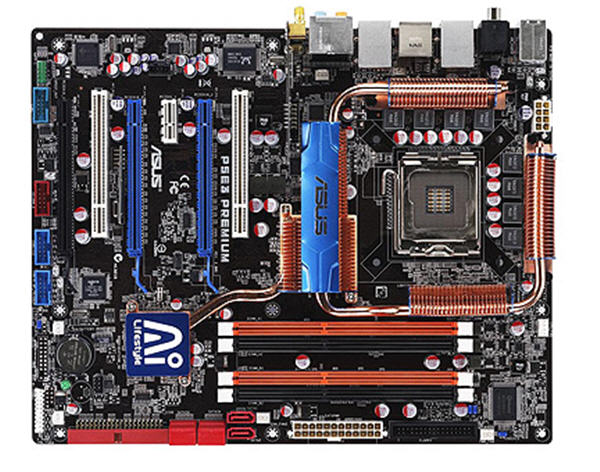
ASUS: The Company

ASUS, a technology-oriented company blessed with one of the world’s top R&D teams, is well known for high-quality and innovative technology. As a leading provider of 3C (computers, communications and consumer electronics) total solutions, ASUS offers a complete product portfolio to compete in the new millennium.
In 2006, the company shipped 55 million motherboards, which means one in three desktop PCs sold last year was powered by an ASUS motherboard. Our 2006 revenues reached US$16.5 billion, and is expected to garner US$23 billion in 2007.
ASUS products’ top quality stems from product development. It’s like learning Chinese Kung-Fu; one must begin with cultivating the “Chi” and inner strength. Besides innovating cutting-edge features, ASUS engineers also pay special attention to EMI (electromagnetic interference), thermal, acoustics and details that usually go unnoticed to achieve complete customer satisfaction. ASUS notebooks are the first TCO’99-certified notebooks worldwide. The requirements for this honor include radiation emission control, energy (battery consumption), ecology (environment friendly) and ergonomics.
To succeed in this ultra-competitive industry, great products need to be complimented by speed-to-market, cost and service. That’s why all 100,000 over employees of ASUS strive for the “ASUS Way of Total Quality Management” to offer the best quality without compromising cost and time-to-market while providing maximum value to all customers through world-class services.
With unyielding commitment to innovation and quality, ASUS won 2,168 awards in 2006, meaning on average, the company received over 5 awards everyday last year. BusinessWeek ranked ASUS amongst its “InfoTech 100” for the 9th straight year. The readers of Tom’s Hardware Guide, the world’s largest IT website, selected ASUS as the best maker of motherboards and graphics cards. Furthermore, the company is ranked as No.1 in quality products and services by the Wall Street Journal.
INTEL® X48 CHIPSET
“With the growing imbalance between CPU and memory performance, it is critical to optimize the memory controller design to obtain the maximum possible performance from the memory subsystem. The redesigned Intel X48 Express Chipset Memory Controller Hub (MCH) architecture significantly increases overall system performance through the optimization of available bandwidth with the new 1600 MHz system bus and reduction of memory access latency with Intel® Fast Memory Access. These technology breakthroughs result in optimized system architecture with built-in intelligence, greatly improving system memory performance. The updated MCH also includes support for Intel 45nm next-generation Intel Core 2 processor family and wider internal data buses that support dual-channel DDR3 memory technology at 1600 MHz. “
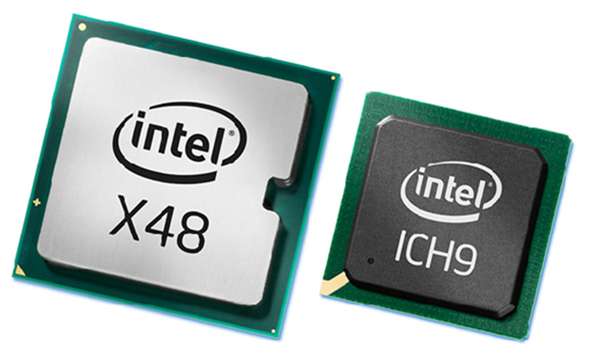
Intel X48 Chips
| Intel® X48 Express Chipset Features & Benefits |
|
| 1600/1333/1066/800 MHz System Bus | Supports the Intel® Core™2 Extreme, Intel® Core™2 Duo and Intel® Core™2 Quad processors, Dual-Core Intel® Pentium® processor, and Intel® Celeron® processor. |
| PCI Express* 2.0 Interface | PCI Express 2.0 delivers up to 16GB/s bandwidth per port, double that of PCIe* 1.0. It provides leading-edge graphics performance with dual X16 graphic card configuration. |
| Intel® Fast Memory Access | Updated Memory Controller Hub (MCH) backbone architecture that improves system performance by optimizing the use of available memory bandwidth and reducing the latency of the memory accesses. |
| Dual-Channel DDR3 memory support | Delivers up to 25.6 GB/s (DDR3 1600 dual 12.8 Gb/s) of bandwidth and 8 GB memory addressability for faster system responsiveness and support of 64-bit computing. |
| Intel® Flex Memory Technology | Facilitates easier upgrades by allowing different memory sizes to be populated and remain in dual-channel mode. |
| Intel® High Definition Audio¹ | Integrated audio support enables premium digital sound and delivers advanced features such as multiple audio streams and jack re-tasking. |
| Intel® Matrix Storage Technology² | With a second hard drive added, provides quicker access to digital photo, video and data files with RAID 0, 5, and 10, and greater data protection against a hard disk drive failure with RAID 1, 5, and 10. Support for external SATA* (eSATA*) enables the full SATA interface speed outside the chassis, up to 3 Gb/s. |
| Intel® Rapid Recover Technology | Intel’s latest data protection technology provides a recovery point that can be used to quickly recover a system should a hard drive fail or if there is massive data corruption. The clone can also be mounted as a read-only volume to allow a user to recover individual files. |
| Serial ATA* (SATA) 3 Gb/s | High-speed storage interface supports faster transfer rate for improved data access. |
| eSATA | SATA interface designed for use with external SATA devices. Provides a link for 3 Gb/s data speeds to eliminate bottlenecks found with current external storage solutions. Provides great flexibility and expandability for external storage solutions. |
| SATA* Port Disable | Enables individual SATA ports to be enabled or disabled as needed. This feature provides added protection of data by preventing malicious removal or insertion of data through SATA ports. Especially targeted for eSATA ports available on the outside of the system. |
| USB* Port Disable | Enables individual USB ports to be enabled or disabled as needed. This feature provides added protection of data by preventing malicious removal or insertion of data through USB ports. |
| All information provided related to future Intel products and plans is preliminary and subject to change at any time, without notice. | |
¹ Intel® High Definition Audio requires a system with an appropriate Intel chipset and a motherboard with an appropriate codec and the necessary drivers installed. System sound quality will vary depending on actual implementation, controller, codec, drivers and speakers. For more information about Intel® HD audio, refer to www.intel.com.
² Intel® Matrix Storage Technology requires the computer have an MST-enabled Intel chipset, RAID controller in the BIOS enabled and the Intel Matrix Storage Technology software driver installed. Please consult your system vendor for more information.
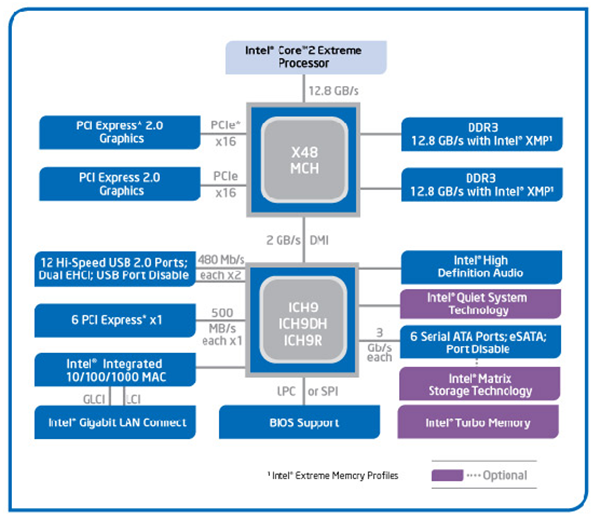
Intel X48 Chipset Block Diagram
The information captioned above was excerpted from the Intel’s Product Overview for the X48 Express Chipset.
FEATURES & SPECIFICATIONS
| ASUS® P5E3 Premium WIFI-AP @n Edition Detailed Specifications |
|
| CPU | Intel Socket 775 Core™2 Quad Core™2 Extreme Core™2 Duo Pentium® Extreme Pentium® D Pentium® 4 Processors Compatible with Intel® 05B/05A/06 processors Support Intel® next generation 45nm CPU |
| Chipset | Intel X48 Intel ICH9R Intel Fast Memory Access Technology |
| Memory | 4 x DIMM, Max. 8 GB, DDR3 2000*/1800*/1600/1333/1066/800 Non-ECC,Un-buffered Memory Dual Channel memory architecture Supports Intel® Extreme Memory Profile (XMP) |
| Expansion Slots | 3 x PCIe x16 1 x PCIe x1 2 x PCI |
| Storage | Southbridge 6 xSATA 3 Gb/s ports Intel Matrix Storage Technology Support RAID 0,1,5,10 JMicron® JMB363 PATA and SATA controller 1 xUltraDMA 133/100/66 for up to 2 PATA devices 2 xExternal SATA 3.0 Gb/s port (SATA On-the-Go) Support RAID 0,1,JBOD |
| LAN | Dual Gigabit LAN controllersMarvell 88E8056® PCIe Gigabit LAN controller featuring AI NET2 Realtek RTL8110SC® PCI Gigabit LAN controller featuring AI NET2 |
| Wireless LAN | ASUS WiFi-AP @n
|
| Audio | ADI® AD1988B 8 -Channel High Definition Audio CODEC Coaxial / Optical S/PDIF out ports at back I/O Support Jack-Sensing, Enumeration, Multi-streaming AI Audio 2 |
| IEEE 1394 | Agere® L-FW3227 1394a controller supports 2 x 1394a ports (one at midboard; one at back panel) |
| USB | 10 USB 2.0 ports (4 ports at mid-board, 6ports at back panel) |
| ASUS AI Lifestyle Features | ASUS Power Saving Solution
|
| Overclocking Features | Intelligent Overclocking Tools
|
| Special Features | Multi-language BIOS ASUS MyLogo 3 |
| Back Panel I/O Ports | 1 x PS/2 Keyboard 2 x External SATA 1 x S/PDIF Out 1 x IEEE 1394a 2 x LAN(RJ45) port 6 x USB 2.0/1.1 8 Channel Audio I/O 2 x WiFi-AP @n antenna jacks |
| Internal I/O Connectors | 2 x USB connectors support additional 4 USB ports 1 x Floppy disk drive connector 1 x IDE connector 6 x SATA connectors 1 x IEEE 1394a connector 1 x CPU Fan connector 1 x Chassis Fan connector 1 x Power Fan connector 1 x COM connector 1 x S/PDIF Out connector 2 x4-pin ATX 12V Power connector 24 -pin ATX Power connector Front panel audio connector Chassis Intrusion connector CD/AUX audio in System Panel Connector |
| BIOS | 16 Mb Flash ROM DMI 2.0 AMI BIOS PnP WfM 2.0 SM BIOS 2.3 ACPI 2.0a Multi-language BIOS ASUS EZ Flash 2 ASUS CrashFree BIOS 3 |
| Manageability | WfM 2.0,DMI 2.0,WOL by PME,WOR by PME, PXE |
| Accessories | UltraDMA 133/100/66 cable FDD cable 6 x Serial ATA cables 1 x 2-port Serial ATA power cable ASUS Q-Shield User’s manual ASUS WiFi-AP @n manual 3 in 1 Q-connector 1 x 2-port USB2.0 1-port IEEE1394 module 2 x Optional Fans for Water-Cooling or Passive-Cooling only ASUS WiFi-AP @n omni-directional antenna |
| Support Disc | Drivers ASUS PC Probe II ASUS AI Suite Anti-virus software (OEM version) ASUS Update ASUS WiFi-AP @n Wizard Image-Editing Suite |
| Form Factor | ATX Form Factor 12 inch x 9.6 inch ( 30.5 cm x24.4 cm ) |
| Dimensions | 270mm x 100mm x 32mm (L x H x D) 10.5in x 3.93in x 1.26in |
PACKAGING & BUNDLED ACCESSORIES
The ASUS® P5E3 Premium WIFI-AP @n utilizes essentially the same stalwart packaging that debuted with the Blitz series of motherboards. The package is considerably taller than past offerings primarily due to having separate inner containers for both the motherboard and the accessories.


As we have stated before in our previous motherboard reviews the amount of accessories included with most of “the new motherboards on today’s market is nothing shy of phenomenal”! ASUS goes well beyond this point with their newest series of boards! Take a gander at what they package with the P5E3 Premium WIFI-AP @n:
- UltraDMA 133/100/66 cable
- FDD cable
- 6 x Serial ATA cables
- 1 x 2-port Serial ATA power cable
- ASUS Q-Shield
- User’s manual
- ASUS WiFi-AP @n manual
- 3 in 1 Q-connector
- 1 x 2-port USB2.0
- 1-port IEEE1394 module
- 2 x Optional Fans for Water-Cooling or Passive-Cooling
- ASUS WiFi-AP @n omni-directional antenna
- Support Disc
- Drivers
- ASUS PC Probe II
- ASUS AI Suite
- Anti-virus software (OEM version)
- ASUS Update
- ASUS WiFi-AP @n Wizard
- Image-Editing Suite
Bundled Accessories
BOARD LAYOUT

- Six SATA-II ports
- Floppy drive connector
- 24-pin ATX socket
- Four Dual-Channel DDR3 slots
- LGA 775 CPU Socket
- PWM Heatsink
- 12 Volt EPA 8-pin connector
- Rear I/O Panel
- Northbridge heat sink
- Two PCI slots
- PCI Express x1 slots
- Three PCI Express 2.0 x16 slot
- SPDIF Out
- Com 1 port
- IEEE 1394 Firewire connector
- Two internal USB connectors
- Southbridge heat sink
- Front panel connector
- JMicron IDE connector
REAR I/O PANEL
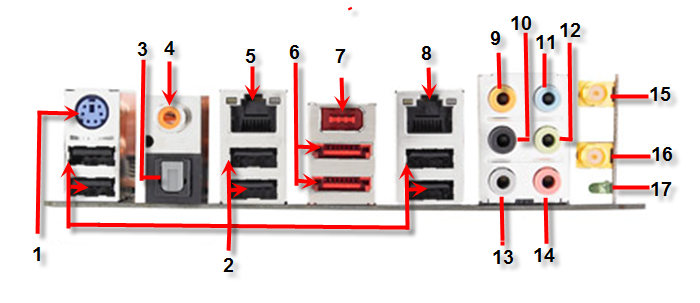
- Keyboard PS-2 Port
- 6 – USB 2.0 Ports
- Coaxial SPDIF out port
- Optical PDIF out port
- Marvll® Gigabit LAN connector
- 2 – E-SATA ports
- IEEE 1394a port
- Realtek® Gigabit LAN connector
- Center/Subwoofer port
- Rear speaker out port
- Line in port
- Line out port
- Side speaker out port
- Microphone in port
- Wireless LAN port 1
- Wireless LAN port 2
- Wireless LAN activity LED
IMAGES & IMPRESSIONS
You can see from your very first glance that the ASUS® P5E3 Premium WIFI-AP @n is no ordinary looking motherboard. While it lacks most of the colorful LEDS and other visual fanfare of its ROG counterpart it makes up for this many other useful features that would appeal to a different type of enthusiast. Don’t let the lack of pomp fool you this board is every bit a performer. As the image below depicts the board is an eye-catcher given its extensive use of copper in the passive cooling elements and is really set off by the cobalt blue northbridge cover with the ASUS logo.

A macro look at the components reveals ASUS has chosen to listen to their users and has used all solid core, high-quality conductive polymer capacitors in lieu of the cheaper, less reliable electrolytic capacitors that have been known to be troublesome on other motherboards. ASUS has also chosen to use their 3rd generation 8-phase VRM power design with this board. This power system utilizes low RDS (on) MOSFETs for minimum switching loss & lower temperatures, Ferrite core chokes with lower hysteresis loss, in addition to the previously mentioned polymer capacitors thus helping to ensure longer component life and lower power loss, creating more energy efficiency.

ASUS has continued it’s use of passive cooling on the P5E3 Premium WIFI-AP @n and taken it to new extremes even for ASUS. The passive cooling element is one continuous product that begins with the PWM on the right rear of the board encircling the entire LG 775 socket and then extending to the northbridge and southbridge. A closer view of the northbridge shows the passive cooling system to be even more substantial than that used on ASUS’s ROG series of boards such as the Maximus Formula. We did notice that the height of the passive cooling unit on the Northbridge might cause some problems for “wide bodied” CPU coolers that didn’t raise the device to around two inches.

The P5E3 Premium/WiFi-AP@n also supports 802.11n WiFi specifications onboard for faster data transfers. ASUS Express Gate is also onboard which uses an optional Linux OS bootup installed on a small flash drive on the board for quick access to the Internet in just a few seconds. Express Gate allows you to enjoy commonly used functions like accessing the Internet, VoIP, and Web emailing without entering the OS. This motherboard supports the latest Intel® Core™2 processors in LGA775 package. It also can support Intel® next generation 45nm Multi-Core CPU. With new Intel® Core™ microarchitecture technology and 1600 / 1333 / 1066 / 800 MHz FSB, the Intel® Core™2 processor is one of the most powerful and energy efficient CPUs currently in production.

The P5E3 Premium/WiFi-AP@n also supports AMD´s CrossFire which boosts image quality along with rendering speed, eliminating the need to scale down screen resolutions to get the high image quality you want. CrossFire ignites with the higher antialiasing, anisotropic filtering, shading, and texture settings you desire. The motherboard supports DDR3 memory that features data transfer rates of 2000(O.C.)/1800(O.C.)/1600/1333/1066/800 MHz to meet the higher bandwidth requirements of the latest operation system, 3D graphics, multimedia, and Internet applications. The dual-channel DDR3 architecture doubles the bandwidth of your system memory to boost system performance, eliminating bottlenecks with peak bandwidths of up to 28.8 GB/s. Furthermore, the supply voltage for the memory is reduced from 1.8 V for DDR2 to just 1.5 V for DDR3. This voltage reduction limits the power consumption and heat generation of DDR3 which makes it a more power efficient, yet powerful memory solution.

The P5E3 Premium/WiFi-AP@n features three x16 PCI-e 2.0 ports for support of the latest PCIe 2.0 devices for double speed and bandwidth which enhances system performance. ASUS EPU utilizes new technology to digitally monitor and tune the CPU power supply with improved VR responses in heavy or light loadings. It automatically provides power for higher performance or improve efficiency by 50% when the PC is running low intensity applications. Working together with AI Gear 3+, this can help you attain the best possible power efficiency and energy savings up to 80.23% to help save the environment.

Stack Cool 2 is a fanless cooling solution offered exclusively by ASUS. It effectively and noiselessly transfers heat generated by the critical components to the other side of the specially designed PCB (printed circuit board) for effective heat dissipation – making temperatures cooler by up to 20°C. The Pure Copper Heat Pipe design effectively directs the heat generated by the chipsets to the heatsink near the back I/O ports – where it can be carried away by existing airflows from the CPU or a bundled optional fan. This innovative and groundbreaking fanless heat pipe design effectively lowers temperatures by up to 10°C without having lifetime problems that a normal chipset fan has. Furthermore, it provides options for users to install side-flow fans or a passive cooler. This Heat Pipe design is the most reliable fanless thermal solution to date.

Another very cool feature on his highly feature laden board is AI Slot Detector. When PCI-e/PCI devices are installed, users can simply plug in the power cable and find out if these devices are successfully installed. Without even switching on the PC or entering the operating system, ASUS´s on-board LEDs provide an efficient way to identify the correct way to set up the PC. A red led indicates something is awry while no LED signal indicates that the PCI-e/PCI device is properly installed. How many times would this feature have saved one of us the embarrassment of having to open the case to properly seat a card or to plug in a PCI-e power adapter that we forgot to properly seat?
BIOS
The BIOS framework for the ASUS® P5E3 Premium/WiFi-AP@n motherboard is per usual controlled by the American Megatrends, Inc. BIOS. The features shown in the images below are from the latest BIOS avialable for the P5E3 at the time we began testing, version 0151.
Main BIOS Screen
The Main BIOS screen appears to be no different than that used on any version of any ASUS BIOS that we’ve seen over the past year. The features here are self explanatory and we won’t insult your intelligence by reviewing each of them.

Extreme Tweaker BIOS Screen(s)
The Extreme Tweaker BIOS screens include all the features relevant to the entire board’s system frequency,memory and voltage, in other words all of the overclocking features are located here. It is quite large and requires several images (below) to be able to view all of the included features.








BIOS
Advanced BIOS Screen(s)
The Advanced BIOS screens contain options for changing: CPU configuration, USB devices, AI Net 2, Northbridge configuration, on-board devices, and Plug and Play options.


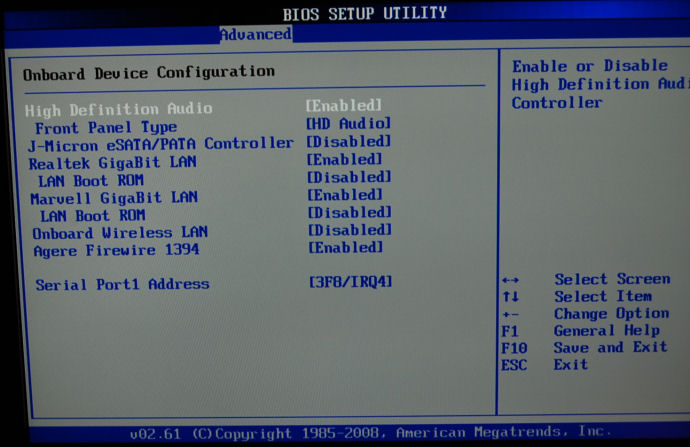

Power BIOS Screen(s)
The Power BIOS screens allow you to change settings for advanced power management and ACPI. Probably the single most interesting feature here is the Hardware Monitor which literally monitors either the RPM, temperature, or voltage on almost every phase of your boards operation. These values can be displayed on screen using the latest version of ASUS Probe II software included with the board on the utilities disk.


We add the next table on the vast majority of our motherboard reviews for the both the computer enthusiast and for the general consumer to use for comparison purposes. The table depicts all of the primary BIOS parameter ranges that would be of interest to anyone thinking of overclocking this board.
| ASUS P5E3 Premium WIFI Ap@on Primary BIOS Parameter Adjustments |
|
| FSB Strap to Northbridge | Auto, 200MHz, 266MHz, 333MHz, & 400MHz |
| FSB Frequency | Auto, 200MHz – 800MHz in 1MHz increments |
| PCI-E Frequency | Auto, 100MHz – 180 MHz in 1MHz increments |
| Dram Frequency | Auto, DDR3: 667, 800, 835, 887, 1002, 1066, 1111, 1333, 1600*, 1800*, 2000* (*To use these straps, system settings have to be automatically set by the motherboard) |
| CPU Voltage | Auto, .85V – 2.10V in .00625V increments (The 0V_CPU jumper must be enabled to reach 2.10V otherwise the max is 1.70V) |
| CPU GTL Voltage Reference 0/2 | Auto, 0.370x – 0.760x in 0.005x intervals |
| CPU GTL Voltage Reference 1/3 | Auto, 0.410x – 0.800x in 0.005x intervals |
| CPU PLL Voltage | Auto, 1.5V – 2.78V in 0.02V increments |
| FSB Termination Voltage | Auto, 1.2V – 1.5V in 0.02V increments |
| Northbridge Voltage | Auto, 1.25V – 2.21V* in 0.02V increments (The 0V_NB jumper must be enabled to reach 2.21V otherwise the max is 1.91V) |
| Northbridge GTL Reference | Auto, 0.61x -0.68x in 0.06x increments |
| DRAM Voltage | Auto, 1.5V – 2.78V in 0.02V increments |
| Southbridge Voltage | Auto, 1.050V – 1.20V in 0.15V increments |
| Clock Over-Charging Voltage | Auto, 0.70V – 1.00V in 0.10V increments |
| DRAM Clock Rate | Auto, 1N, 2N |
| DRAM Clock Skew Channel A/B | Auto, Advanced: 50ps – 350ps, in 25ps increments, Normal, Delayed: 50ps – 350ps, in 25ps increments |
| DRAM CMD Clock Skew Channel A/B | Auto, Advanced: 25ps – 175ps, in 25ps increments, Normal, Delayed: 25ps – 175ps, in 25ps increments |
| DRAM Clock Twister | Auto, Lighter, Light, Moderate, Strong, Stronger |
| DRAM Dynamic Write Control | Auto, Enabled, Disabled |
| DRAM Static Read Control | Auto, Enabled, Disabled |
| AI Clock Tuner | Auto, Manual, X.M.P. |
TESTING METHODOLOGY & TOOLS
Test Methodology
As we alluded to in the introduction, we decided to test the ASUS® P5E3 Premium/WiFi-AP@n using both the Intel® Q6600 65nm Quad processor and X3350 45nm procesor to see just how much variance there is between the two CPUs. We ran the Q6600 using a multiplier of 8 and a FSB of 333 to mimic the X3350 as much as possible for this heads-up comparison. We also tested the X3350 utilizing the ASUS Maximus Formula motherboard to get a direct comparison between the X38 and the X48 based motherboards. It should be noted though that the Maximus Formula uses DDR2 as opposed to DDR3 on the P5E3. We assembled a group of benchmarks, captioned below that we feel are readily accessible and more importantly free to the public sector for our testing, We feel the benchmarks chosen when completed will be representative of this system’s complete performance. You will also note that we ran all of the tests that were specific to 64-bit Vista operating system utilizing the recently released SP1. We also utilized both Dx9 and Dx 10 for our gaming and GPU tests. All benchmarks were run a minimum of three times and an average of the results were posted.
| Test Platform | |
| Processor | Intel X3350 Core 2 Quad Intel Q6600 Core 2 Quad |
| Motherboard | ASUS P5E3 Premium WIFI-AP @n, BIOS 0151 ASUS Maximus Formula(Non-SE) X38, BIOS 0907 |
| Memory | 4GB OCZ DDR3 PC3-12800 Platinum, 7-6-6-24 2GB Patriot Viper DDR3-15000, 8-8-8-24 4GB Mushkin XP2 DDR2 6400, 1066MHz @5-5-5-18 |
| Drive(s) | 2 – Seagate 1TB Barracuda ES SATA Drives |
| Graphics | XFX GeForce® 8800 GT XXX running ForceWare 169.25 64-bit WHQL
|
| Cooling | Enzotech Ultra w/ 120mm Delta Fan |
| Power Supply | Antec 650 Watt Neo Power & Antec 550 Watt Neo Power |
| Display | Dell 2407 FPW |
| Case | Antec P190 |
| Operating System | Windows Vista Ultimate 64-bit SP1 |
Unfortunately when testing a motherboard there is not set of “grass roots” tests that will speak to the motherboard’s overall performance. It is therefore necessary to comparatively test the performance of the CPU, Memory, Hard Drive(s) and Graphical Rendering and then we’ll draw assumptions from the results of these tests.
|
Synthetic Benchmarks |
|
PCMark Vantage x64 |
|
PCMark05 |
|
3DMark06 v. 1.1.0 |
|
SiSoft SANDRA XII Professional |
|
Everst Ultimate Edition v. 4.20.1170 |
|
SuperPi Mod 1.5XS |
|
HD Tach RW 3.0.1.0 |
|
Cinebench R10 64 bit |
|
Games |
|
Crysis 32 & 64 bit … Dx9 & Dx 10 |
|
Company of Heroes v. 1.71 … Dx9 & Dx 10 |
PCMARK VANTAGE
“PCMark® Vantage is the first objective hardware performance benchmark for PCs running 32 and 64 bit versions of Microsoft® Windows Vista®. PCMark Vantage is perfectly suited for benchmarking any type of Microsoft® Windows Vista PC from multimedia home entertainment systems and laptops to dedicated workstations and hi-end gaming rigs. Regardless of whether the benchmarker is an artist or an IT Professional, PCMark Vantage shows the user where their system soars or falls flat, and how to get the most performance possible out of their hardware. PCMark Vantage is easy enough for even the most casual enthusiast to use yet supports in-depth, professional industry grade testing.”
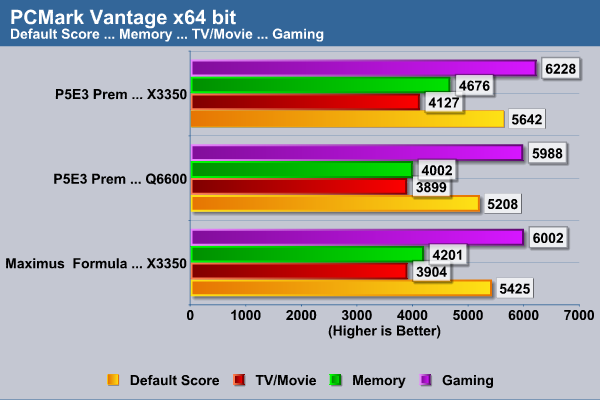
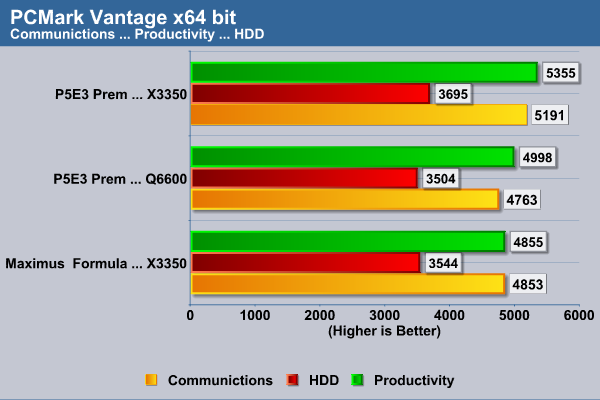
PCMARKO5
“PCMark®05 is everything you need to reliably and easily measure the performance of your PC and determine its strengths and weaknesses. With PCMark05, you will be able to select the optimal upgrades for your existing PC, or choose the right new PC that fits your specific needs. This easy-to-use product gives you the same tools and knowledge that virtually every professional tester in the industry uses. “

CINEBENCH
“CINEBENCH is a real-world test suite that assesses your computer’s performace capabilities. MAXON CINEBENCH is based on MAXON’s award-winning animation software, CINEMA 4D, which is used extensively by studios and production houses worldwide for 3D content creation. MAXON software has been used in blockbuster movies such as Spider-Man, Star Wars, The Chronicles of Narnia and many more. MAXON CINEBENCH runs several tests on your computer to measure the performance of the main processor and the graphics card under real world circumstances. The benchmark application makes use of up to 16 CPUs or CPU cores and is available for Windows (32-bit and 64-Bit) and Macintosh (PPC and Intel-based). The resulting values among different operating systems are 100% comparable and therefore very useful with regard to purchasing decision-making. It can also be used as a marketing tool for hardware vendors or simply to compare hardware among colleagues or friends.”
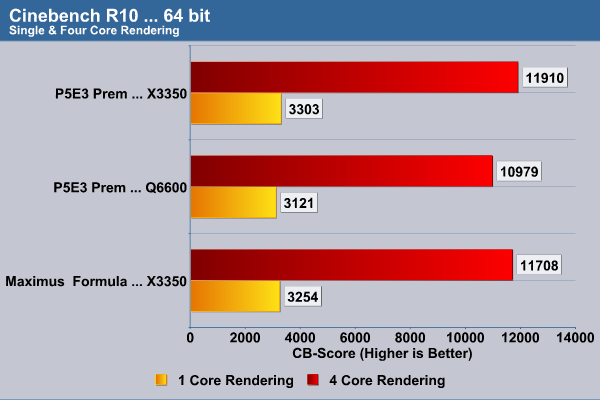
SANDRA PROFESSIONAL
“SiSoftware Sandra (the System ANalyser, Diagnostic and Reporting Assistant) is an information & diagnostic utility. It should provide most of the information (including undocumented) you need to know about your hardware, software and other devices whether hardware or software. It works along the lines of other Windows utilities, however it tries to go beyond them and show you more of what’s really going on. Giving the user the ability to draw comparisons at both a high and low-level. You can get information about the CPU, chipset, video adapter, ports, printers, sound card, memory, network, Windows internals, AGP, PCI, PCI-X, PCIe (PCI Express), database, USB, USB2, 1394/Firewire, etc.”
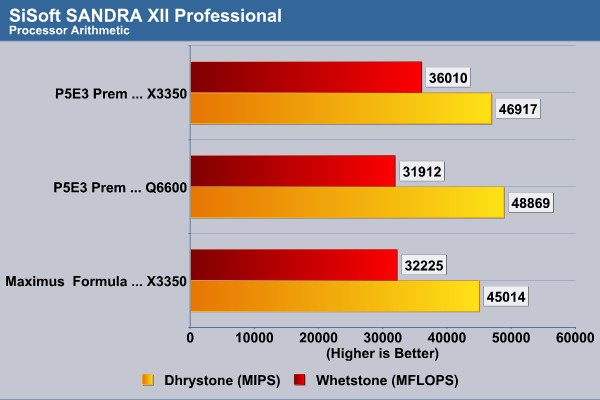

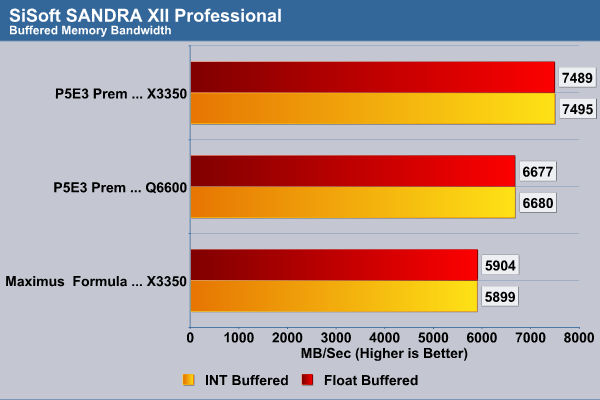
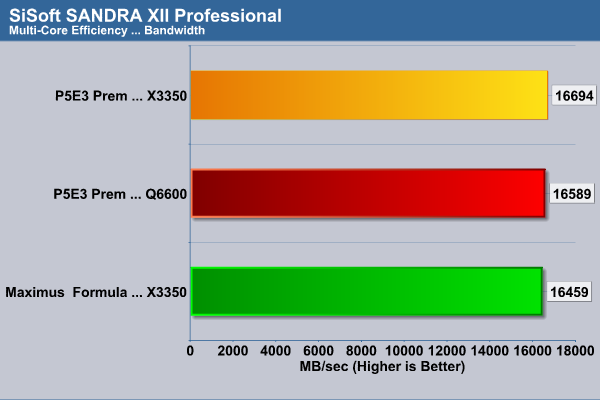
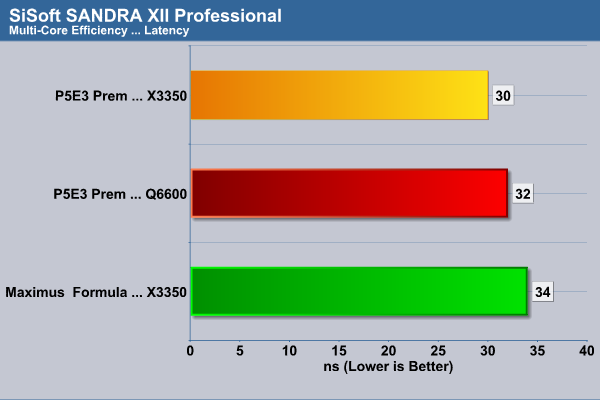
EVEREST ULTIMATE
“EVEREST Ultimate Edition is an industry leading system diagnostics and benchmarking solution for enthusiasts PC users, based on the award-winning EVEREST Technology. During system optimizations and tweaking it provides essential system and overclock information, advanced hardware monitoring and diagnostics capabilities to check the effects of the applied settings. CPU, FPU and memory benchmarks are available to measure the actual system performance and compare it to previous states or other systems. Furthermore, complete software, operating system and security information makes EVEREST Ultimate Edition a comprehensive system diagnostics tool that offers a total of 100 pages of information about your PC.”
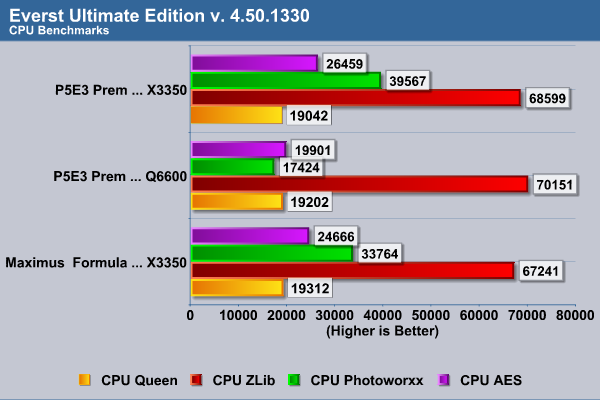
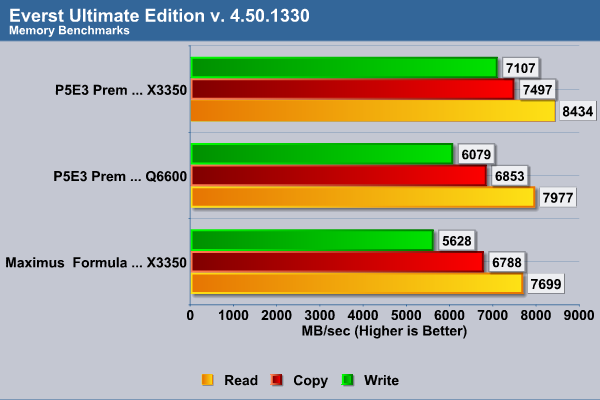
SUPERPi
SuperPi which is the “Gold standard” for many when it comes to judging system performance. We ran 1 and 2 Meg calculations again running each test three times and reporting the average of the results.
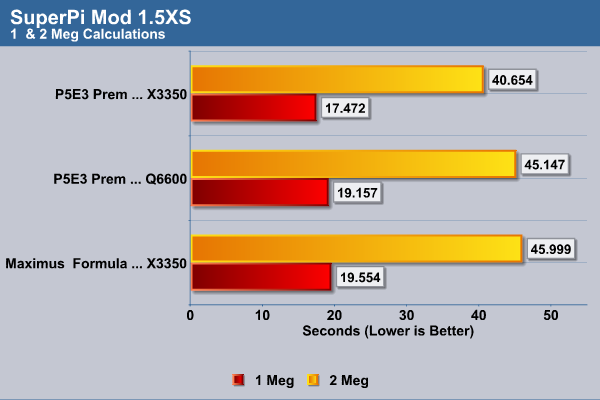
HD TACH-RW
HD TACH RW performs sequential read and write test on removable media and non-partitioned fixed disks. HD Tach RW is also capable of performing the sequential read and write tests on the entire disk instead of the small number of zones in the quick and long test. We opted to use the Long 32(MB) tests in the sequential read mode only as sequential writes is covered by other benchmarks.
|
Seagate 1TB ES Performance … HDT-RW 3.0.1.0 |
||
| ASUS P5E3 Premium | ASUS Maximus Formula
|
|
| Random Access Time* (ms) | 13.0 | 13.2 |
| Average Read Time (MB/sec)
|
88.4 | 86.3 |
| CPU Utilization* | 1% | 2% |
| Burst Speed (MB/sec) | 174.8 | 162.5 |
|
*Lower is Better … Otherwise Higher is Better |
||
3DMARK06
3DMark06 developed by Futuremark is a synthetic benchmark used for universal testing of all graphics solutions. 3DMark06 features HDR rendering, complex HDR post processing, dynamic soft shadows for all objects, water shader with HDR refraction, HDR reflection, depth fog and Gerstner wave functions, realistic sky model with cloud blending, and approximately 5.4 million triangles and 8.8 million vertices; to name just a few. The measurement unit “3DMark” is intended to give a normalized mean for comparing different GPU/VPUs. It has been accepted as both a standard and a mandatory benchmark throughout the gaming world for measuring performance.
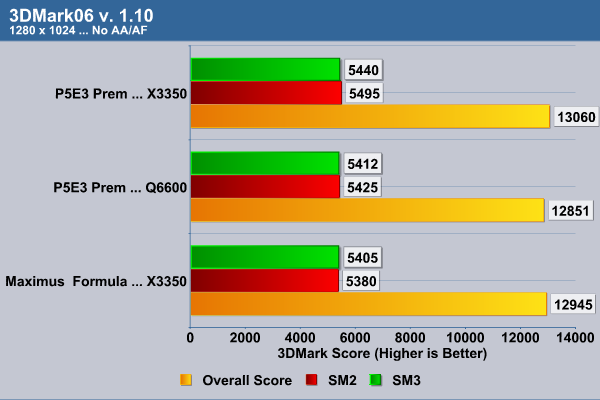
COMPANY OF HEROES
Company of Heroes(COH) is a Real Time Strategy(RTS) game for the PC, announced on April, 2005. It is developed by the Canadian based company, Relic Entertainment, and published by THQ. We gladly changed from the first-person shooter based genres of the rest of our gaming benchmarks to this game which is RTS. Why? COH is an excellent game that is incredibly demanding on system resources thus making it an excellent benchmark. Like F.E.A.R. the game contains an integrated performance test that can be run to determine your system’s performance based on the graphical options you have chosen. It uses the same multi-staged performance ratings as does the F.E.A.R. test. We salute you Relic Entertainment!

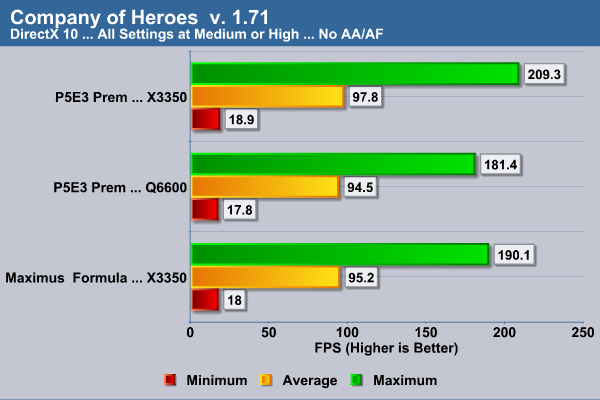
CRYSIS
Crysis is the most highly anticipated game to hit the market in the last several years. Crysis is based on the CryENGINE™ 2 developed by Crytek. The CryENGINE™ 2 offers real time editing, bump mapping, dynamic lights, network system, integrated physics system, shaders, shadows and a dynamic music system just to name a few of the state of-the-art features that are incorporated into Crysis. As one might expect with this number of features the game is extremely demanding of system resources, especially the GPU. We expect Crysis to be a primary gaming benchmark for many years to come.
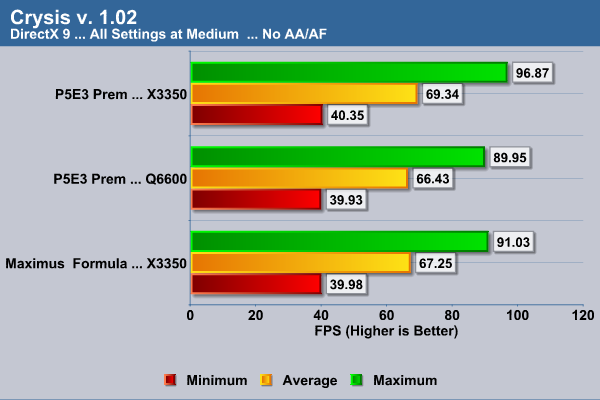
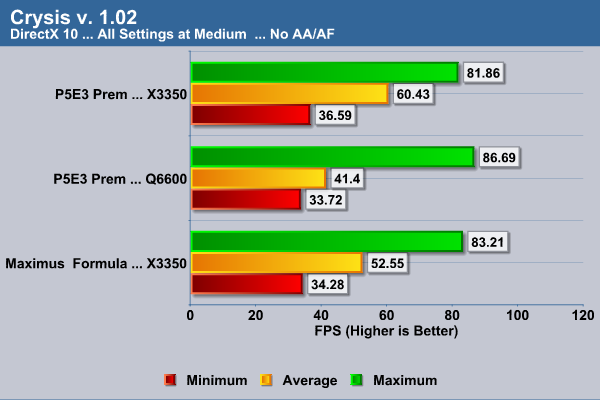
POWER
Power conservation appears to be a current mission for the vast majority of motherboard manufacturers, and with good reason. It is our opinion that the trend over the last year of having to buy huge, and in most cases extremely expensive power supplies to make your system perform up to its peak is not the direction we need to be headed in. ASUS has made a commitment to help keep power demand low on your system when you don’t need peak performance and for most users that would average between 70% – 80% of the time. ASUS makes the following statement concerning their efforts with the ASUS P5E3 Premium WIFI Ap@on:
“The ASUS EPU utilizes innovative technology to digitally monitor and tune the CPU power supply with improved VR responses in heavy or light loadings. It automatically provides power for higher performance or improve efficiency by 50% when the PC is running low intensity applications. Working together with AI Gear 3+, this can help you attain the best possible power efficiency and energy savings up to 80.23% to help save the environment.”
To test these claims we the AI Gear 3+ drivers which work in conjunction with the AI Suite of utilities. It should be noted that for this utility and the drivers for AI Gears 3+ to work correctly all BIOS settings should be set to Auto. The first image you see below is the AI screen with all settings unchanged:
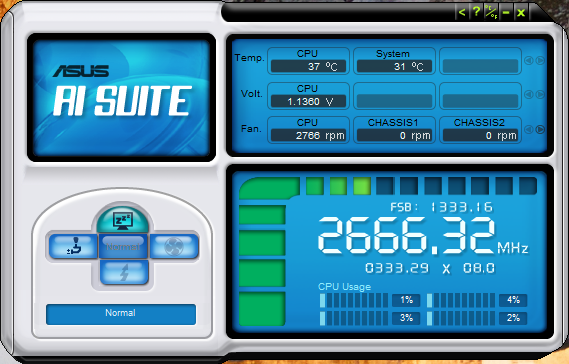
AI Suite in Normal Mode
Next we opened the AI Gear screen and opened the accompanying energy savings calculator to see what savings if any normal mode would yield.

Energy Savings Calculator Showing Normal Mode
As we expected there are no energy savings in normal mode. We then adjusted the AI Gear 3+ to the highest energy savings and again took a few of screen shots to show the results detailed in the images below.

AI Gear 3+ at Highest Energy Savings
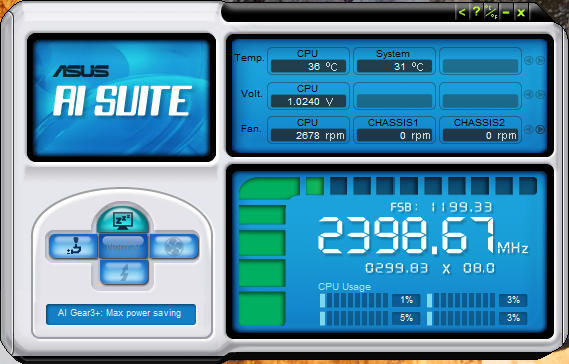
AI Suite Depicting Highest Energy Savings

Energy Savings Calculator Showing Highest Energy Savings
In the two energy saver screen images we see almost an eleven Watt savings at idle, not shabby at all. Now if this were a static process and not dynamic you would be severely hampered in day to day operations should your need for speed increase. Thankfully ASUS realized this and built the software in such a way that the CPU power is constantly being monitored and adjusted to meet your needs. Now for the ultimate test we chose to run benchmarks with Crysis which we all know is one of the most highly demanding games on system resources. In the graph below we compare the differences utilizing the energy savings feature and running your system in normal mode.
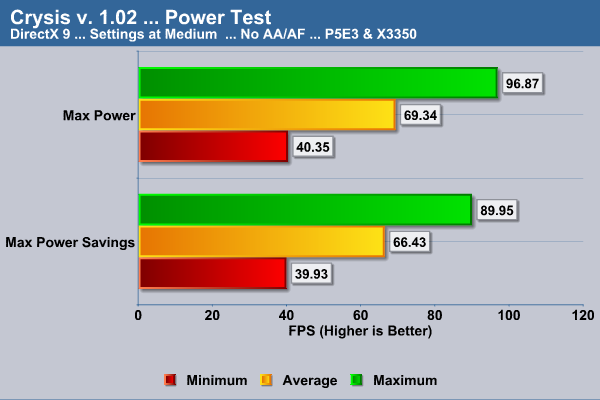
As we can see there is less than a 3 FPS drop in the game’s average frame rate which actually surprised us as we were expecting it to take a bigger hit. We repeated the test numerous times and continually got the same results give or take a few tenths of a watt. For the potential energy savings this utility offers we will gladly sacrifice 3 FPS on any game any day.
OVERCLOCKING
Now on to our favorite area of any review, overclocking. We’ll admit that after reading a number of previews of the ASUS P5E3 Premium WIFI Ap@on where either the Intel® E8400 or E8500 Wolfdale processors were overclocked to rather extreme levels we were expecting similar performance from the Intel® X3350 quad core. We decided to also overclock our Q6600 for comparison purposes. After a couple of hours of playing we reached an FSB of 447 yielding an effective overclock of 3.576 GHz this was achieved utilizing the chip’s stock multiplier of 8. This was the highest attainable overclock we were able to reach no matter what we did on both processors. We tried increasing the FSB some 20 MHz higher in case there was an FSB wall, increasing all voltages, changing the multiplier and running a higher FSB, and adjusting every other BIOS setting that we felt would help to improve this mark. Nothing did! Strangely enough we encountered the same identical issue with the Q6600 and were also unable to move beyond the mystical FSB of 447 also using a multiplier of 8. This was in the same stable max clock range that we experienced when testing the Q6600 with the Maximus Formula.
We even tried changing the memory strap and found no differences in our ability to overclock at either the 1333MHz strap or the 1111MHz. The only difference we found between the two straps was that we had to change to our 2 GB kit of Patriot Viper DDR3 1500 memory to benchmark at the 1300MHz strap as the OCZ 4GB kit we were using would not boot at 1788 MHz which was the effective memory clock using this strap. To achieve this degree of overclock with the X3350 we used a VCore of 1.30V, a Northbridge setting of 1.5V, and a VDimm of 1.9V, with the Q6600 we had to use a VCore of 1.425 and the same settings for the Northbridge and VDimm. Below you see our results:
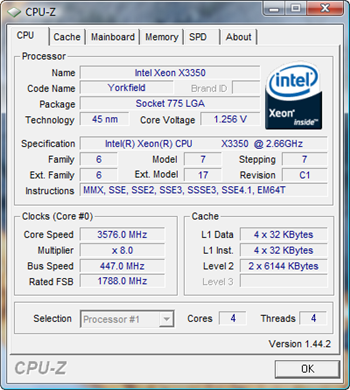

OC 447 FSB at 1111MHz Memory Strap
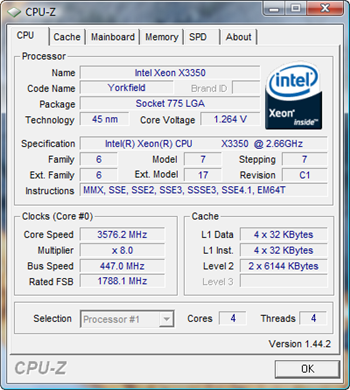
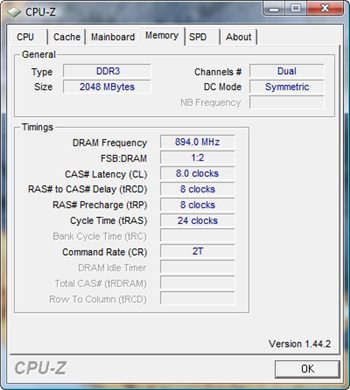
OC 447 FSB at 1333MHz Memory Strap
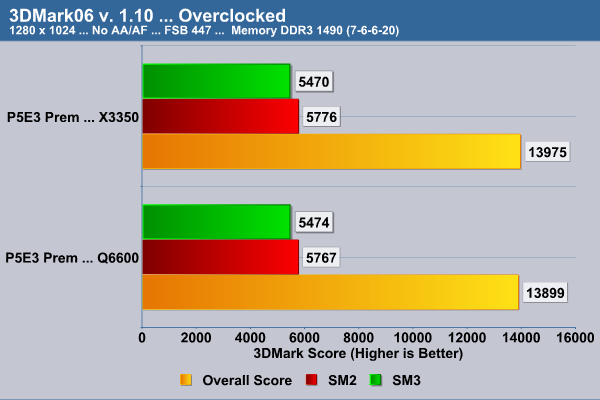
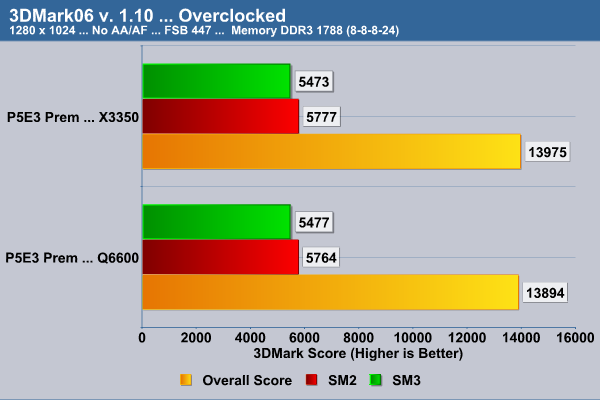
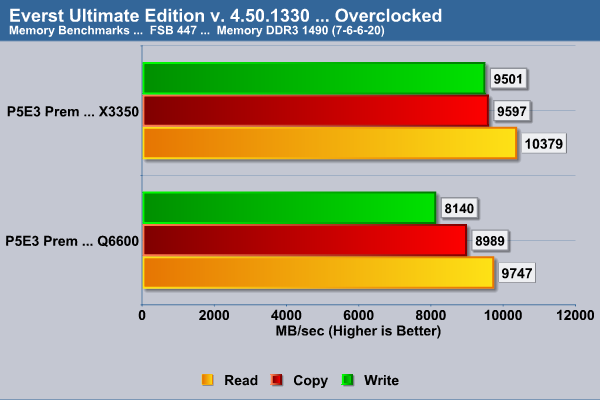


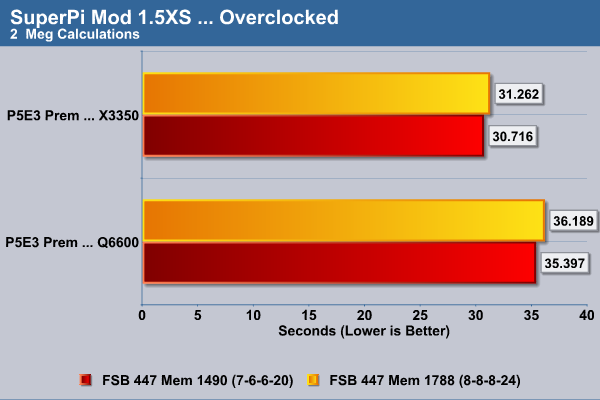
In all our years of overclocking we experienced some very strange issues in this benchmarks we ran after achieving our maximum overclock: 1) We would have expected much higher 3DMark06 scores at this level of OC; and 2) We would have expected better performance from the higher memory strap on all tests. We have a number of ideas why, but those that we feel are the most accurate entail: 1) We are using the newly released SP1 with Vista 64 Ultimate and it doesn’t seem as fast; 2) The fact that the OCZ memory was both a 4GHz kit and had lower latency than the Patriot memory attributed to the higher scores although not significantly higher. We will delve much deeper into the memory performance as we intend to do extensive reviews on both the OCZ DDR3 12800 Platinum and the Patriot Viper DDR3 15000 in the very near future. We’re not a huge fan of Vista and still feel that many of the issues we and others are experiencing are Vista related. At this point given the infancy of this motherboard’s BIOS and the fact that it performs at the top of the heap with the dual core Wolfdale processor we can only surmise at this stage in the game that it’s not as friendly toward the quad core processors as we’d like to see.
CONCLUSION
The ASUS P5E3 Premium WIFI Ap@n is ASUS’s top of the line X48 motherboard that currently retails in the $350.00 to $400.00 USD range. It is highly feature laden and in our testing all of the features worked as advertised which is quite exceptional in today’s market. The board is extremely well built using only the best components as it should be for the price that you are paying. The P5E3 Premium coupled with the Intel® X3350 Core 2 Quad processor yielded excellent results in most of the non-overclocked benchmarks that we ran, especially those relating to memory.
The layout of the ASUS P5E3 Premium WIFI Ap@n is among the best we’ve seen with the possible exclusion of the tight confines around the socket 775 which may cause problems for some wide bodied coolers that don’t have the height to clear the passive cooling elements. We also found the audio to be subjectively the best we’ve experienced from an on-board solution. The Express Gate is a great feature that allows the user access to the Internet without the need to boot the boaard’s full operating system. The only drawback of Express Gate is that it doesn’t provide the space to download and retrieve a necessary component you might need in an emergency.
While we are aware that many enthusiasts do not have power consumption in the forefront of their minds, we, however begrudgingly, realize its an eventuality that we all must face. The ASUS EPU utilizing the Ai Suite and the AI Gear 3+ control panel and drivers does an excellent job of conserving energy without sacrificing much in the way of performance. We also realize that the cost of this board may preclude it from some user’s consideration. Overall performance was quite good in most cases besting the X38 by 15% or more which is significant.
The only real downside to P5E3 is that in its present state it does not overclock the Core 2 Quad processors as well as we would have hoped for. This presents a bit of a conundrum as we’ve seen a number results showing it to be one of, if not the best overclocking boards available when using the Intel® Core 2 Quad 45nm Wolfdale processors. After doing a bit more research we find that almost everyone is experiencing the FSB limitations similar to ones reported in this review with the 45nm Core 2 Quad cores. For that reason we certainly can’t fault ASUS in the design of this board. We can recommend that if you want premium results with this board and apparently many others, the 45nm Wolfdale would be the processor of choice; not to mention saving you a fe $$$ in the process.
When it comes to recommendations we find this board to be in a league of its own from the standpoint of features. The X48 P5E3 Premium does outperform our Maximus Formula X38 board by an average mark ranging from 12%-15%. Whether that is enough of a performance increase to justify the expense of this board is a question you’ll have to answer for yourself. From our standpoint at Bjorn3D it will be one of the boards that we class as a “keeper” and one we’ll use regularly in future reviews.
Pros:
+ ASUS EPU does an excellent job of conserving energy without sacrificing performance
+ Extremely Feature Laden
+ A BIOS that is an enthusiast’s dream
+ Passive cooling of PWMs, North and Southbridge is exceptional
+ CrossFire™ Certified
+ PCI-E 2.0 support
+ On board AI Slot Detector to detect PCI-e/PCI board installation errors
+ Support for all current Socket 775 Core 2 Duo and Core 2 Quad processors
+ Exceptionally stable
Cons:
– Price might be a deterrent to some
– Some wide bodied CPU coolers may not fit
– Express Gate doesn’t have the space or accessibility to download
– Does not overclock the Core 2 Quad nearly as well as the Core 2 Duo 45nm processors
Final Score: 8.0 out of 10 and the Bjorn3D Seal of Approval.
 Bjorn3D.com Bjorn3d.com – Satisfying Your Daily Tech Cravings Since 1996
Bjorn3D.com Bjorn3d.com – Satisfying Your Daily Tech Cravings Since 1996




